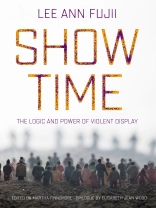In Show Time , Lee Ann Fujii asks why some perpetrators of political violence, from lynch mobs to genocidal killers, display their acts of violence so publicly and extravagantly. Closely examining three horrific and extreme episodes—the murder of a prominent Tutsi family amidst the genocide in Rwanda, the execution of Muslim men in a Serb-controlled village in Bosnia during the Balkan Wars, and the lynching of a twenty-two-year old Black farmhand on Maryland’s Eastern Shore in 1933—Fujii shows how ‘violent displays’ are staged to not merely to kill those perceived to be enemies or threats, but also to affect and influence observers, neighbors, and the larger society.
Watching and participating in these violent displays profoundly transforms those involved, reinforcing political identities, social hierarchies, and power structures. Such public spectacles of violence also force members of the community to choose sides—openly show support for the goals of the violence, or risk becoming victims, themselves. Tracing the ways in which public displays of violence unfold, Show Time reveals how the perpetrators exploit the fluidity of social ties for their own ends.
表中的内容
Introduction
1. Fixations: The Making and Unmaking of Categories
2. Rehearsal
3. Main Attraction
4. Intermission
5. Sideshow
6. Encore
7. Fictions: The Making and Unmaking of Boundaries
Epilogue
关于作者
Lee Ann Fujii was associate professor of political science at the University of Toronto and a member of the School of Social Science at the Institute for Advanced Study in Princeton. She is author of Killing Neighbors and Interviewing in Social Science Research.Martha Finnemore is University Professor of Political Science and International Affairs at George Washington University.Elisabeth Jean Wood is the Crosby Professor of the Human Environment and Professor of Political Science, International and Area Studies at Yale University.












